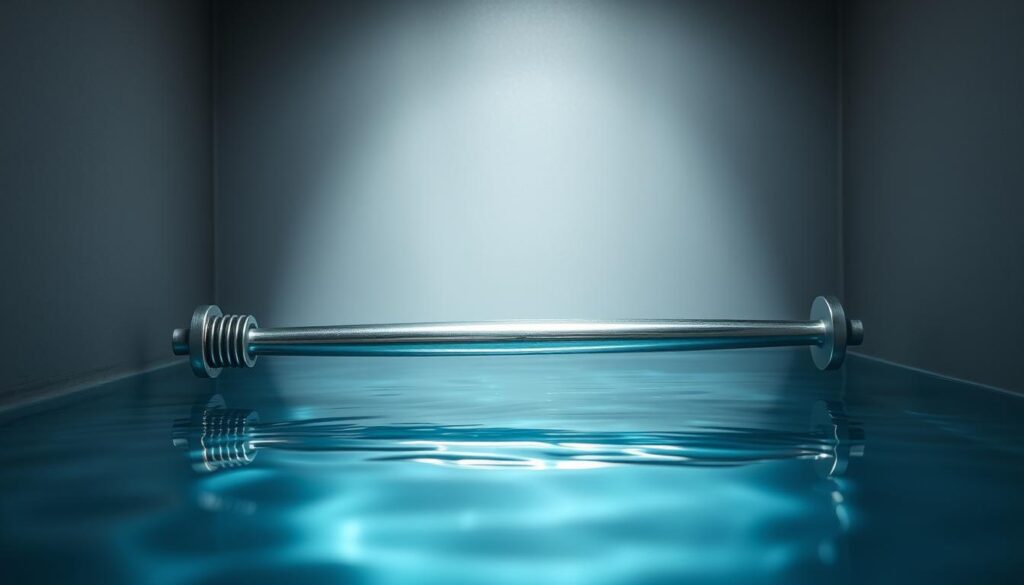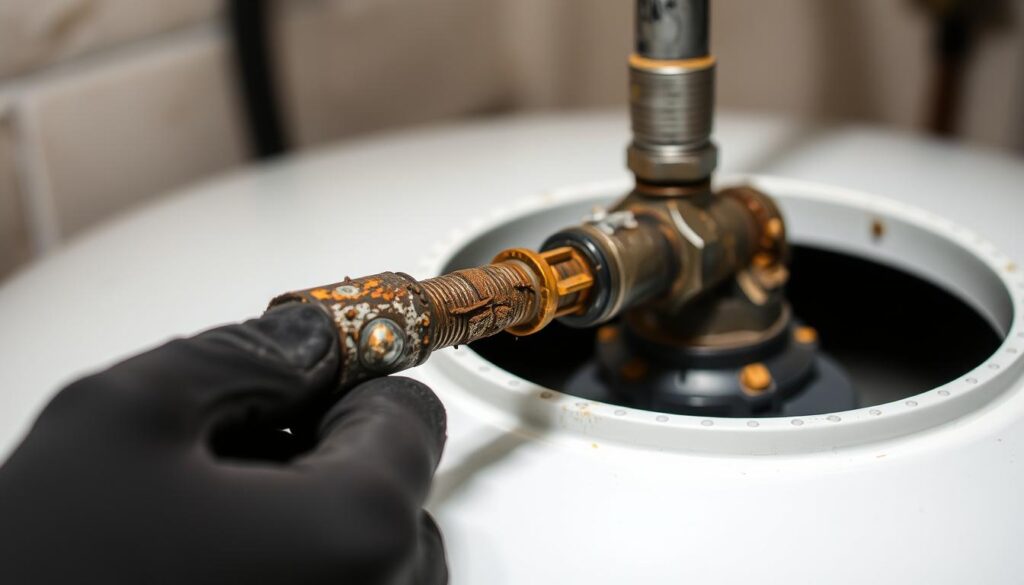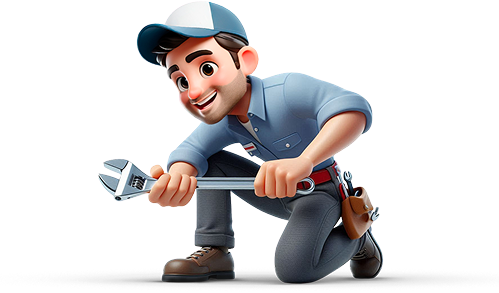We start with the key search intent: you want practical steps to protect your storage tank and keep hot water reliable today. We explain why the anode and anode rod matter, how they stop corrosion, and when to act so your water heater keeps working.
Glass-lined steel storage heaters rely on a sacrificial rod to take corrosion so the tank does not. In Melbourne, even with low TDS, small units can exhaust this protection in four to five years if unchecked.
We are OnCall Emergency Plumbers — Melbourne’s 24/7 team for urgent and routine plumbing, blocked drains, burst pipes and leak fixes. Call us on 1800 571 216 or visit our site for service and quality parts. For local guidance, see our hot water repairs in Broadmeadows.
This short guide sets expectations: we’ll show how the rod works, what tools you need, safe prep steps and when to engage a licensed pro. Follow these tips to reduce leaks, improve efficiency and extend system life.
Key Takeaways
- Inspect the sacrificial rod regularly to prevent tank corrosion and leaks.
- Glass-lined steel heaters need this service more than other designs.
- In Melbourne, check smaller units sooner — wear can occur within 4–5 years.
- We explain DIY limits and when to call a licensed professional.
- OnCall provides 24/7 emergency help, warranty-safe work and trusted brands.
Why sacrificial anodes matter for your hot water storage tank in Australia
A small metal rod does big work: it takes on corrosion so your storage heater’s steel tank survives longer. This protects the cylinder and keeps hot water reliable for households and businesses across Melbourne and beyond.
All mains‑pressure glass-lined storage water heaters depend on a sacrificial anode, while stainless steel and continuous flow units generally do not. Local water quality—hardness, TDS and pH—changes how fast the rod wears, so inspection intervals vary by area.
In cities like Melbourne and Sydney, small units can exhaust protection in as little as four to five years. Manufacturers therefore advise scheduled checks to preserve the tank and keep warranty conditions valid.
Usage, thermostat settings and pressure swings also influence wear. Regular care improves system reliability, reduces odours or discoloured water, and helps maintain energy efficiency.
- Protects the tank: intercepts corrosive activity before it reaches steel.
- Varies by water quality: local conditions change service intervals.
- We are available 24/7: if you want reassurance, we provide prompt inspection and quality parts across Melbourne.
How sacrificial anodes protect your hot water tank
Corrosion starts from tiny electrical currents where metal meets water. We fit a sacrificial anode so those currents attack the rod instead of the steel cylinder.

The process is simple and electrochemical. The sacrificial rod is a more reactive metal joined to the tank. It releases ions and becomes the part that corrodes, while the tank behaves as a cathode and stays intact.
Which heaters need one?
Mains‑pressure glass‑lined storage tanks rely on a rod. Stainless steel, copper storage units, gravity‑feed ceiling tanks and continuous-flow gas heaters generally do not require this protection.
- Material: magnesium rods give a strong protective current in fresh water.
- Passivation: coating from calcium carbonate can stop a rod working even if it looks thick.
- Size matters: longer, thicker rods last longer but must match the manufacturer’s spec.
If you’re unsure about your water heater anode or rod access, we can inspect and advise. Contact OnCall for 24/7 support across Melbourne.
Tools, safety and prep for anode replacement
Planning the job and isolating energy sources keeps everyone safe and the heater intact. Below we list what to bring and how to prepare before you touch fittings.
What we’ll need
- Socket wrench with a 27 mm (1-1/16”) hex head socket.
- Plumber’s tape for thread sealing and a garden hose or bucket for drained water.
- Good gloves, eye protection and a second person for steadying the unit if needed.
Safe isolation and draining
We switch off electricity at the breaker for electric units or turn off gas at the valve for gas models before touching fittings.
Next, shut the cold water supply valve to the heater, open a hot tap to relieve pressure, then attach a hose to the drain valve and drain a few litres. This lowers the water level below the anode port and reduces spills.
- Avoid penetrating oil or hammering the hex head — measured torque with the correct socket is safer.
- Ensure stable footing and good leverage; have someone steady the heater if extra force is needed.
Need help? We provide 24/7 service in Melbourne and can manage isolation, draining and safe anode rod work. See our hot water repairs in Black Rock for local support.
Step-by-step: replace anode rod (electric and gas hot water systems)
We present a clear, safe sequence for electric and gas heaters so you can service the heater anode without surprises. Follow each step and pause if you need a licensed plumber to assist.

Locate the port and access the rod
Isolate power or turn off the gas, then shut the cold water supply. Open a hot tap to lower pressure and attach a garden hose to the drain valve to remove a few litres.
Check the top cap or side port under the lid to confirm access and clearance for a rigid or flexible rod.
Loosen the hex head safely
Use a 27 mm (1-1/16″) socket wrench on the hex head. Have a helper steady the tank to avoid twisting pipework.
Avoid hammering or penetrating oil; steady leverage and short, controlled force work best.
Remove, inspect and fit the new rod
Pull the old rod and inspect for pitting or heavy brown/white coating. Sharp grey pitting shows active protection; a coated or exposed core means it needs replacement.
Choose flexible or rigid as space requires. Wrap threads with plumber’s tape, hand-thread the new rod, then use the wrench for about a half-turn to finish—firm, not over-torqued.
Refill, purge air and final checks
Close the drain valve, open the cold water supply and leave a hot tap running to purge air until flow is steady. Check around the port and nearby fittings for any weeping.
Restore power or relight the gas, then set the thermostat to a sensible temperature. If you prefer a licensed pro at any step, we can attend 24/7 — or see our hot water repairs in Rosebud for local support.
When to replace the anode rod and how often in Australia
Spotting early signs of wear lets you act before the tank itself is harmed. We recommend yearly checks and targeted servicing so issues are fixed while they are small.
Key signs you need replacement
Watch for rusty or sulphur-smelling water, popping or rumbling from the cylinder, or a sudden rise in energy bills. These point to failing protection inside your hot water tank.
On inspection a heavily coated or exposed steel core on the rod means the heater anode has lost effectiveness and we advise prompt action.
Service intervals and practical timing
Most Australian conditions suit an inspection every year and a change roughly every three to five years. In softened or harsh water you may need service sooner.
Many makers list five to ten years for broader checks, but local water quality, frequent draw cycles and high thermostat settings shorten the life.
When it’s too late
If corrosion has already started inside the tank, failure can follow within a few years. On units around 12 years old, replacing the rod may not restore meaningful life.
- Check cold water supply shutoff and safe drainage before planning work.
- If unsure, we provide on-site assessment and urgent service across Melbourne 24/7.
Need help? Call OnCall Emergency Plumbers on 1800 571 216 for clear pricing, quality parts and scheduled checks or urgent service.
Choosing the right anode and when to call OnCall Emergency Plumbers
A well‑matched rod and correct size will save you service time and extend tank life. We help you pick the best material for local water quality, and step in when a job needs a licensed person.
Material matters: magnesium vs aluminium‑zinc
Magnesium gives strong protection in fresh water and is our usual first choice for many Melbourne homes. In harder water or where odour appears, aluminium‑zinc alloys suit better.
Stainless steel storage tanks typically do not need a rod. Many models, however, require a flexible rod because ceiling clearance limits fitment.
Why call a professional in Melbourne
If the hex head is seized, using excessive force can damage pipework or the tank. That’s when you should call a licensed person.
- We offer 24/7 service for electric and gas heaters, with quality parts from trusted brands.
- We match rod length and size to manufacturer specs and local water system conditions.
- Call us on 1800 571 216 or visit https://oncallemergencyplumbers.com.au/ for urgent help fitting a new anode and warranty‑safe work.
Conclusion
We recommend a short annual check to keep your hot water heater reliable. A small investment to replace anode parts every three to five years protects the tank and saves money long term.
Follow safe steps: isolate supply and power, lower pressure, use the correct 27 mm hex socket on the top plug, drain carefully and purge air on refill. Check for leaks at the valve and around fittings.
Glass‑lined storage heaters need the most attention; stainless and continuous‑flow heaters usually do not. If you notice discolouration, odour, popping or pressure issues, act quickly to replace anode rod or get advice.
For Melbourne‑wide, 24/7 help with heaters, blocked drains, burst pipes and leaks call us on 1800 571 216 or visit https://oncallemergencyplumbers.com.au/. We provide experienced, affordable service and trusted parts to extend your water tank life.
FAQ
What does the sacrificial rod do in our hot water storage tank?
The sacrificial rod protects the steel tank by corroding in place of the metal shell. This cathodic protection reduces rust and prolongs the tank’s life, helping us avoid early tank failure and leaks.
How do we know if the rod needs replacing?
Key signs include rusty or discoloured hot water, a rotten-egg smell, popping or banging noises from the tank, higher energy bills and visible corrosion when inspected. If the rod shows heavy pitting, an exposed core or a thick white coating, we recommend replacing it.
How often should we check the rod in Australian homes?
Service intervals vary with water quality and use. As a general guide, inspect every three years and consider replacement every three to five years. In hard or corrosive water districts we may check and replace more frequently.
Can we fit a new rod ourselves or should we call a professional?
Competent DIYers can change the rod if they follow safety steps: isolate electricity or gas, shut the cold-water supply, relieve pressure and use correct tools. Call a licensed plumber if we’re unsure, if the access is difficult, or if the tank shows serious corrosion.
What tools and materials do we need for a rod swap?
We typically need a socket wrench with a 27mm (1-1/16”) hex head socket, a garden hose to drain water, plumber’s tape or thread sealant and a stabilising method for the tank. Flexible rods or rigid types may require different handling.
What safety steps should we follow before starting work?
Switch off the power supply or gas, close the cold-water inlet, open a hot tap to relieve pressure and attach a hose to the drain valve to lower the water level safely. Always wear eye protection and gloves and avoid working alone if unsure.
Where is the rod located on common hot water systems?
On electric storage tanks it’s often under the top access cap; on gas units it may be through a side port. Continuous-flow (instant) units and stainless-steel tanks may not have one, so check the manufacturer’s manual first.
What differences matter when choosing a replacement rod?
Material choice matters — magnesium suits softer water, while aluminium‑zinc can work better in hard or high‑chloride supplies. Size and thread must match the tank’s fitting, and we should choose reputable brands and corrosion‑resistant finishes.
How do we install the new rod correctly?
After draining to a safe level, remove the old rod with the hex socket, inspect the port, apply thread sealant, and fit the new rod to the correct torque. Refill slowly, purge trapped air via hot taps, check for leaks and restore power or gas when the tank is full.
When is it too late to save the tank?
If the tank shows widespread rust, weeping seams, large perforations or is beyond its expected service life, replacement is often safer and more economical. A professional inspection can confirm whether repair or replacement is best.
Does water quality affect how long the rod lasts?
Yes. Hard water, high dissolved solids or salty supplies accelerate corrosion of the rod and the tank. We recommend water testing and possibly a different rod material or additional water treatment in aggressive supplies.
Can replacing the rod improve hot water efficiency?
Indirectly. A healthy tank avoids leaks and sediment build‑up that can reduce heat transfer. Replacing a depleted rod helps prevent corrosion and maintains system efficiency, which may lower energy costs over time.
Who should we call for urgent service in Melbourne?
For 24/7 emergency assistance and parts from trusted brands, contact a licensed plumbing service with experience in hot water systems. They can inspect the tank, recommend the correct rod type and carry out safe installation.

